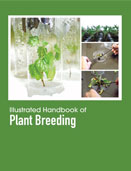Handbooks

Plant breeding is an applied branch of Botany, which deals with improvement of agricultural crops. This branch of agricultural science has contributed maximum to the increase in food production all over the world and therefore, now a day it assuming ever increasing importance in field of agriculture in every country. Plants have been successfully selectively bred for thousands of years, culminating in incredible yields, quality, and resistance and so on that we see in our modern day crops and ornamental plants. In recent years the techniques used have been rapidly advanced and refined to include molecular, cell and genetic techniques. This book offers the most recent detailed knowledge of plant reproduction and their environmental interaction, which can help guide new breeding programs and help insure continuing progress in providing more food for growing populations.
Plant breeding is the science driven creative process of developing new plant varieties that goes by various names including cultivar development, crop improvement, and seed improvement. Plant breeders employ a variety of techniques to improve the genetic composition of the crop and a successful strategy is dependent on the physical, physiological and hereditary characteristics of the plant. Different breeding approaches are required for self-pollinating, cross-pollinating and clonally-propagated plants. The methods used by plant breeders have developed along with the advancement of human civilization and have expanded to incorporate humanity?s increased knowledge of genetics. While implying breeding methods breeder always considers multiple characters, even in conditions where any single character is dominant. Characters are considered depending on various factors like crop, growing area etc. For example, a farmer who wants to select a plant with resistance to an insect pest will watch for the plants that survive an insect attack. Another farmer wanting larger fruits will save seeds from plants yielding the biggest fruits in the field. The most important factor for basic selective breeding is to start with plenty of genetic variation (top diagram) and to select and multiply the characteristic of interest (bottom diagram). As a result from breeding, most of the species we rely on for food are very different from their wild relatives.
Illustrated Handbook of Plant Breeding aims to improve the characteristics of plants so that they become more desirable agronomically and economically. The modern age of plant breeding began in the early part of the twentieth century, after Mendel?s work was rediscovered. Today plant breeding is a specialized technology based on genetics. It is now clearly understood that within a given environment, crop improvement has to be achieved through superior heredity. From times immemorial, the plant breeding has been helping the mankind. With knowledge of classical genetics, number of varieties have been evolved in different crop plants. Since the population is increasing at an alarming rate, there is need to strengthened the food production which is serious challenge to those scientists concerned with agriculture. Advances in molecular biology have sharpened the tools of the breeders, and brighten the prospects of confidence to serve the humanity. The application of biotechnology to field crop has already led to the field testing of genetically modified crop plants. Genetically engineered rice, maize, soybean, cotton, oilseeds rape, sugar beet and alfalfa cultivars are expected to be commercialized before the close of 20th century. Genes from varied organisms may be expected to boost the performance of crops especially with regard to their resistance to biotic and abiotic stresses. In addition, crop plants are likely to be cultivated for recovery of valuable compounds like pharmaceuticals produced by genes introduced into them through genetic engineering. This book is suitable for the students and researchers engaged in the genetic improvement of crop plants through the study and application of genetics, statistics, agronomy, plant pathology, entomology, and related sciences.